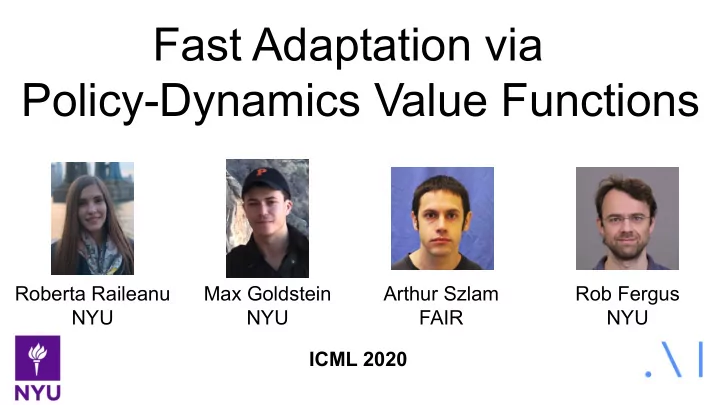

Fast Adaptation via Policy-Dynamics Value Functions Roberta Raileanu Max Goldstein Arthur Szlam Rob Fergus NYU NYU FAIR NYU ICML 2020
Dynamics Often Change in the Real World
How can agents rapidly adapt to changes in the environment’s dynamics ? Learn a General Value Function in the Space of Policies and Dynamics
Policy-Dynamics Value Function (PD-VF) Value Function Total Future Reward Fixed Policy-Dynamics Total Future Reward Value Function
Fast Adaptation to New Dynamics Family of Environments Each Environment has a unobserved Different Transition Function Train on a Family of Different but Related Dynamics Test on New Dynamics
Training Recipe 1. Reinforcement Learning Phase - train individual policies on each training environment 2. Self-Supervised Learning Phase - Learn policy and dynamics embeddings using collected the trajectories 3. Supervised Learning Phase - Learn a value function for this space of policies and environments 4. Evaluation Phase - Infer the dynamics of a new environment using steps - Find the policy that maximizes the learned value function
Learning Policy and Dynamics Embeddings Learn Policy Embedding Learn Dynamics Embedding
Learning the Policy-Dynamics Value Function Training the Policy-Dynamics Value Function
Evaluation Phase Closed-form solution: top singular vector of A’s SVD decomposition Optimal Policy Embedding (OPE)
Environments Spaceship Swimmer Ant-Wind Continuous Dynamics Ant-Legs Ant-Legs Discrete Dynamics
Evaluation on Unseen Environments
Evaluation on Unseen Environments
Learned Embeddings Policy Embeddings Dynamics Embeddings Policy Color Dynamics Color
Takeaways Learn a value function in a space of policies and dynamics Infer the dynamics of a new environment from only a few interactions No need for parameter updates, long rollouts, or dense rewards to adapt Improved performance on unseen environments
Future Work ● Reward function variation → condition W on a task embedding ● Multi-agent settings → dynamics given by the others’ policies ● Continual learning ● Integrate prior knowledge / constraints ● Estimate other metrics apart from reward
Thank you!
Recommend
More recommend